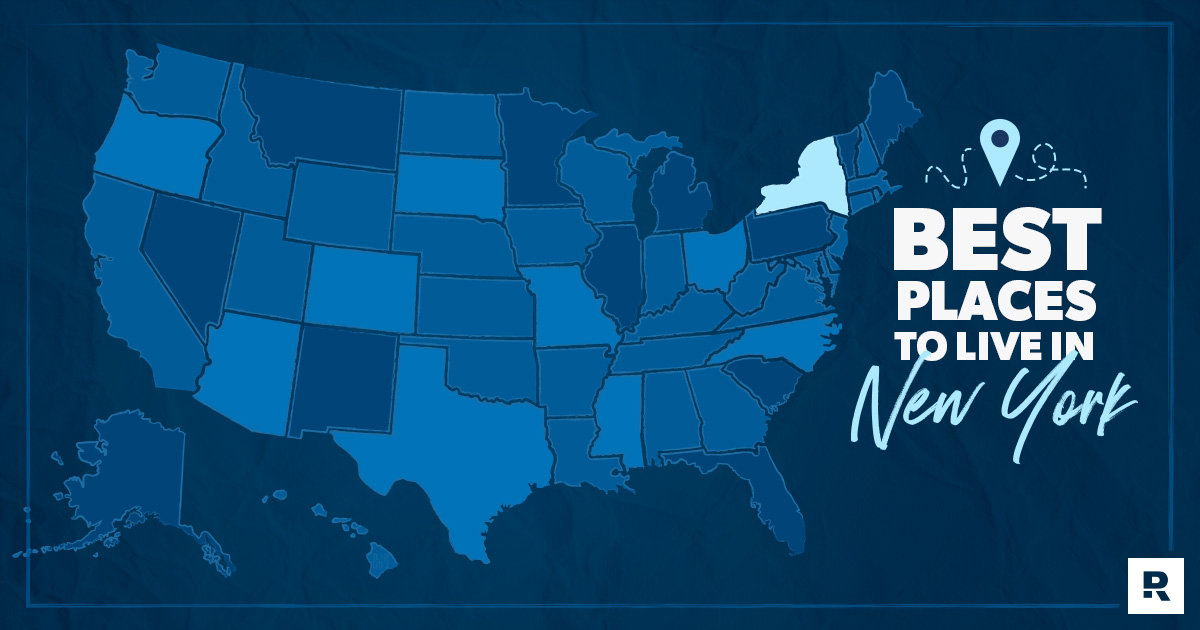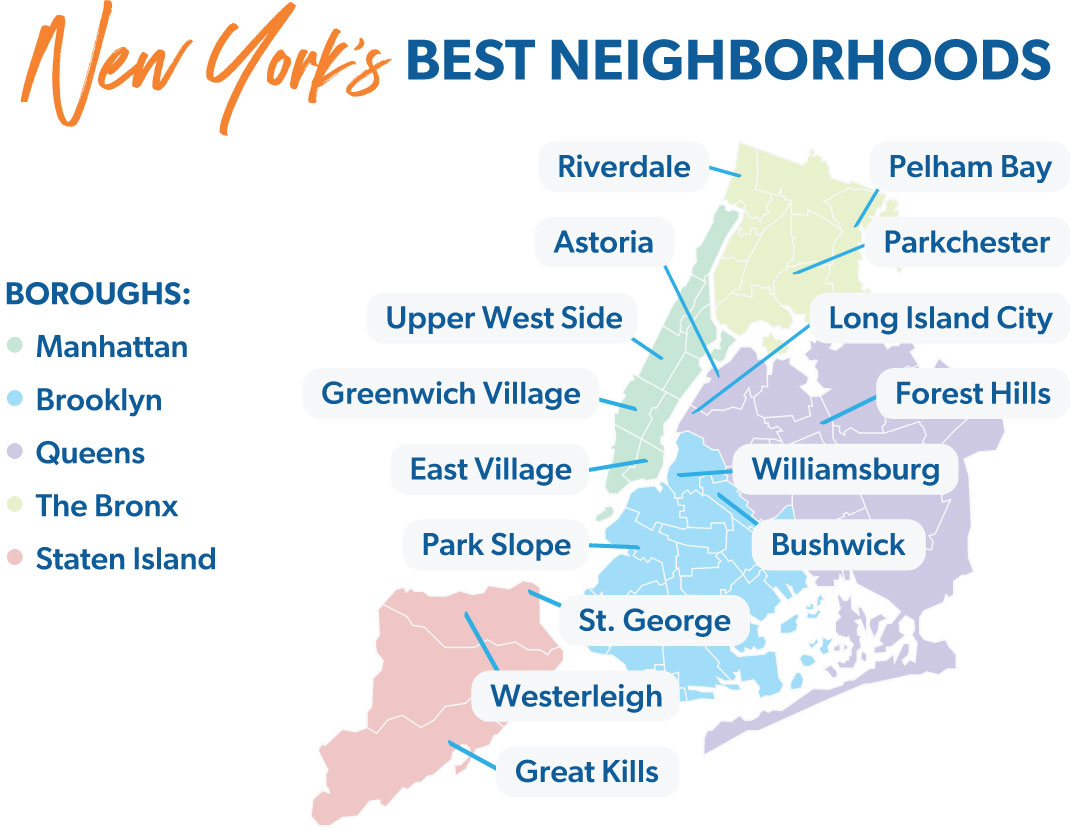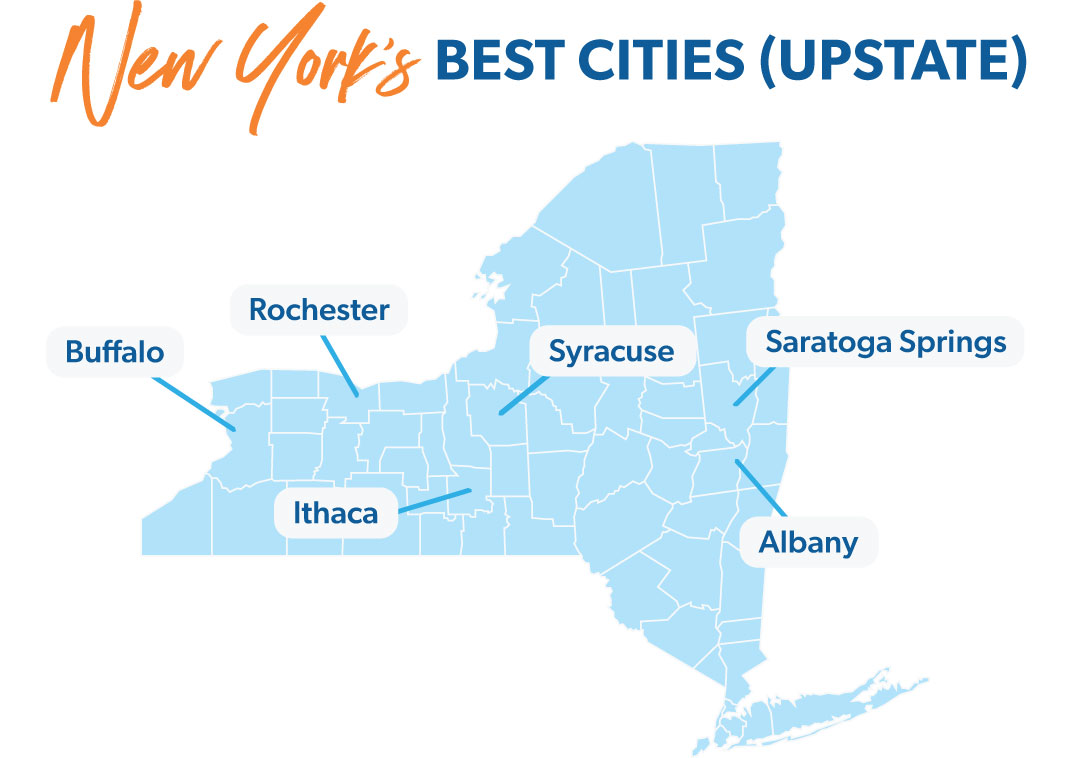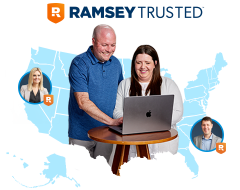Best Places to Live in New York
17 Min Read | Feb 20, 2024

Thinking about packing your bags and moving to New York, but a little bit lost as to which location to choose? Don’t worry—you’re definitely not alone. After all, New York can be kind of confusing. You may have questions like, What exactly is “upstate” New York? Or, What’s the difference between Manhattan and Brooklyn?
So, let’s answer those questions and go over the best places to live in New York. Keep this in mind though: The best place for you to live in New York (or anywhere else for that matter) will depend on your individual situation and preferences. You may prefer a slower pace of life and a more tight-knit local community, or you may be itching to head straight for Times Square. You may even be looking for a great retirement destination.
As you go through this list, think about which places are the best fit for you.
Where are the Best Places to Live in New York?
We’ll start by looking at some of the best places to live in New York City, then we’ll dive into upstate New York. Here’s a road map:
- Best Places to Live in New York City
- Best Neighborhoods in Manhattan
- Best Neighborhoods in Brooklyn
- Best Neighborhoods in Queens
- Best Neighborhoods in the Bronx
- Best Neighborhoods in Staten Island
- Best Places to Live in Upstate New York
Best Places to Live in New York City
If you’re considering a move to NYC, it’s not hard to see why you think living in the Big Apple would be a dream come true. And the truth is, living in New York can be unbelievably exciting and great for your career. But here’s what you need to know: Life in New York is expensive. As in, well over twice the average cost of living in the rest of the U.S.1 As in, forking over a ton of your paycheck for federal, state and local taxes. As in, sometimes paying over $4,000 a month for rent. You get the picture.
So, here’s what we’ll say about living in NYC: Don’t do it if you can’t afford it. To be specific, your monthly housing payment shouldn’t be more than 25% of your take-home pay, and you should be able to comfortably afford your other living expenses (food, utilities, transportation, etc.) while still having enough left over to save for emergencies, retirement or paying off debt.
If you can make living in NYC work financially—by making a huge income or living in a shoebox with several roommates—go for it. If not, hold your horses.
To give you a better idea of what to expect and which location in the city might be the best fit for you, let’s take a look at the best places to live in each of New York’s five boroughs: Manhattan, Brooklyn, Queens, the Bronx and Staten Island.

Best Neighborhoods in Manhattan
When people call New York the “city that never sleeps,” they’re usually talking about the lifestyle and culture of Manhattan. It’s where you’ll find most of NYC’s major tourist attractions—like the Empire State Building, Times Square, the 9/11 Memorial and Museum, and Broadway theater.
|
Population* |
1.6 million2 |
|
Median Household Income |
$95,8663 |
|
Median Home Listing Price |
$1.6 million4 |
|
Median Rent |
$4,0505 |
|
Unemployment Rate |
4.1%6 |
*Data in tables collected in January 2024.
Here’s a look at the top neighborhoods in Manhattan:
- Upper West Side: An upper-middle-class neighborhood in uptown Manhattan with plenty of connections to the rest of the city through multiple subway lines. It’s close to Lincoln Center, the Metropolitan Opera House, and Central Park.
- East Village: Home to some of the best nightlife in all of NYC with all kinds of dive bars, cocktail bars and even a hotel rooftop or two. You’ll also find a lot of live music performance spaces in East Village, lending to its bohemian vibe.
- Greenwich Village: Known for its quiet side streets, artsy culture and world-class pizza. The Village is also home to Washington Square Park and the famous Strand Book Store, which is nearly 100 years old and carries over 2.5 million books.
Best Neighborhoods in Brooklyn
Want easy access to all Manhattan has to offer without paying over $4,000 a month to live in a shoebox? Brooklyn is a more affordable alternative with notably bigger and nicer living spaces. Compared to Manhattan, Brooklyn is much more laid back—it’s a lot quieter, and there’s not nearly as much going on outside of the downtown area. You’ll also find a much stronger community feel in Brooklyn than in Manhattan, since it’s not a huge tourist hot spot.
|
Population |
2.6 million7 |
|
Median Household Income |
$73,9518 |
|
Median Home Listing Price |
$800,0009 |
|
Median Rent |
$3,46910 |
|
Unemployment Rate |
5.3%11 |
These are three of the most popular Brooklyn neighborhoods:
- Williamsburg: An upscale neighborhood that’s become super popular among people moving to NYC. It’s got tons of great local restaurants, shops and parks, and it’s just a 10-minute commute from Manhattan.
- Park Slope: Full of beautiful brownstone apartments that’ll give you more bang for your buck in space and quality than anything in Manhattan. It’s also more laid-back than other areas of Brooklyn—you won’t find much of a party all night attitude in Park Slope.
- Bushwick: A perfect location for anyone looking to integrate into New York hipster culture. Bushwick is known for its street art scene, and it offers several different housing options—everything from industrial lofts to traditional apartments.
Don’t buy or sell without an agent you can trust.
There are RamseyTrusted real estate agents all over the country who are ready to help you win.
Best Neighborhoods in Queens
The largest of New York’s five boroughs geographically, Queens is where you’ll find NYC’s two biggest airports (JFK and LaGuardia), in addition to Citi Field, the home of the New York Mets. It has a reputation for being the friendliest borough, which is why it’s a popular place in NYC to raise a family.
|
Population |
2.3 million12 |
|
Median Household Income |
$80,55713 |
|
Median Home Listing Price |
$575,00014 |
|
Median Rent |
$3,48515 |
|
Unemployment Rate |
4.5%16 |
Here are a few of the best places to live in Queens:
- Astoria: A neighborhood with a lot of history and culture, including the bridge that inspired the design of the Sydney Harbor Bridge. Astoria has a big Greek population, which means plenty of great Greek food, in addition to awesome pizza and other NYC favorites. It’s also well connected to Manhattan with access to multiple subway lines.
- Long Island City: A more affordable alternative to Manhattan that’s just 10 minutes from Central Park and a little over 15 minutes from Times Square. A lot of the buildings in Long Island City are significantly newer than those across the water in Manhattan, which means they’re usually much nicer and offer better options. Long Island City is also one of the more “livable” neighborhoods in NYC, with plenty of grocery stores and doctors to choose from.
- Forest Hills: One of few places in Queens where you’ll find a suburban feel (as much as you can have a suburban feel in NYC, that is). Forest Hills has a nice mix of traditional apartments and traditional houses as well as plenty of parks and other green spaces.
Best Neighborhoods in the Bronx
New York’s second-most culturally and ethnically diverse borough (Queens is number one), the Bronx has a large Italian and Hispanic population—which means it’s home to some of the best Italian and Latin food in America. It’s also home to Yankee Stadium, and it’s the only borough connected to the mainland of New York state.
|
Population |
1.4 million17 |
|
Median Household Income |
$45,51718 |
|
Median Home Listing Price |
$335,00019 |
|
Average Rent |
$1,82720 |
|
Unemployment Rate |
7.0%21 |
Here’s preview of three standout neighborhoods in the Bronx:
- Riverdale: Offers its residents a good balance of city life and a suburban atmosphere. Riverdale has a big Jewish community, which means you’ll find lots of kosher restaurants, including a kosher Dunkin’. When it comes to public transportation in Riverdale, buses are more prominent than subways—some locals even get around the very commutable neighborhood by car.
- Parkchester: Gives residents a peaceful, quiet place to live while still being a five-minute walk from hopping on a train and heading into the hustle and bustle of Manhattan. Parkchester is full of beautiful nature and landscaping, and the neighborhood operates with a small-town mentality. Still, you’ll find all the shopping destinations you need to buy groceries, clothes and other essentials without leaving Parkchester.
- Pelham Bay: Home to Pelham Bay Park, the largest public park in all of NYC—at close to 3,000 acres, it’s more than three times the area of Central Park. Pelham Bay is a mostly residential area with a suburban feel, tree-lined streets, and a mix of apartment buildings and single-family homes.
Best Neighborhoods in Staten Island
Often called NYC’s “forgotten” borough, Staten Island is full of towns that feel like traditional suburban cities. It’s fairly detached from the relentless pace and busyness of Manhattan, the majority of its real estate is residential (no skyscrapers), and most Staten Island residents own a car instead of using public transportation—the only borough where that’s the case.
|
Population |
491,13322 |
|
Median Household Income |
$93,16423 |
|
Median Home Listing Price |
$675,90024 |
|
Average Rent |
$1,95025 |
|
Unemployment Rate |
4.9%26 |
These three Staten Island locations are among the best:
- Great Kills: One of Staten Island’s most popular moving destinations for families. Great Kills offers several different types of single-family homes, playgrounds and Little League Baseball teams—it’s a lot like your typical American small town. The only difference is, Great Kills residents can take a quick train ride to the Staten Island Ferry, which offers free round trips to Manhattan (and one of the best views of the Statue of Liberty you’ll get in all of NYC).
- Westerleigh: Probably the closest thing in all of NYC to a “normal” town that you’d find anywhere else in the U.S., complete with residential areas, shopping centers and parks. Westerleigh also offers quick bus rides to the Staten Island Ferry.
- St. George: Features a mix of older homes and newer construction, and offers its residents plenty of things to do—like watching the Staten Island FerryHawks minor league baseball team, going shopping at Empire Outlets, and enjoying a concert at the St. George Theatre. The area is also very close to the Staten Island Ferry, so St. George residents are always just a quick trip away from Manhattan.
Best Places to Live in Upstate New York
The definition of upstate New York can change depending on who you ask. However, most people living in New York tend to agree that upstate refers to everything in the state of New York outside of New York City and Long Island. So that’s the definition we’ll work with here.
See how much house you can afford with our free mortgage calculator!
If you’re considering a move to upstate New York, you should be prepared for plenty of snow and cold temperatures during the winter. But despite the harshness of wintertime, plenty of cities in upstate New York offer their residents a great place to live with exciting things to do, a beautiful outdoors scene, and a reasonable cost of living.
Here’s a look at six of the best ones, in no particular order.

Rochester
Up first on our list is Rochester, home to the University of Rochester and Abbot’s Frozen Custard, where locals are known to line the streets waiting for a serving of fresh custard. Unlike a lot of other upstate New York cities on our list, Rochester isn’t close to a major metro area—so don’t plan on taking frequent weekend trips to Boston or Manhattan.
However, that doesn’t mean Rochester is boring. With a minor league baseball team and the many outdoor activities that come with being part of the Finger Lakes region, people living in Rochester have plenty of fun in their city. They also enjoy not dealing with the kind of traffic you find in major metro areas—a big plus for commuters. (Just make sure you learn about the city’s unique winter parking rules.)
Though there’s plenty of snow in Rochester, don’t expect your kids to get a whole lot of snow days. Schools and offices in Rochester tend to have a deal with it mentality when the roads get rough—after all, it happens all the time.
|
Population |
209,32527 |
|
Median Household Income |
$43,63128 |
|
Median Home Listing Price |
$250,00029 |
|
Median Rent |
$1,30030 |
|
Unemployment Rate |
3.6%31 |
Buffalo
Speaking of snow, let’s head out to Buffalo next. Home to an NFL team (the Bills), an NHL team (the Sabres) and a ton of great food, Buffalo is another great option for anyone wanting to move to upstate New York.
Buffalo sometimes gets a bad rap as being a boring, dreary place to live, but it’s just not true—there’s always plenty going on. In addition to its pro sports teams, Buffalo is a common stop for touring Broadway shows and big-name music artists. It’s also got a year-round outdoors scene with both warm-weather and cold-weather activities—everything from swimming and sailing to skiing and sledding.
Plus, the city’s economy is in great shape. Thanks to a business environment that’s friendly to start-ups, Buffalo has plenty of job opportunities in everything from technology to manufacturing. Its housing market is also competitive, though rent is still very affordable. And to top it all off, Buffalo’s cost of living is 6% less than the national average.37
|
Population |
276,49132 |
|
Median Household Income |
$48,90433 |
|
Median Home Listing Price |
$250,00034 |
|
Median Rent |
$1,30035 |
|
Unemployment Rate |
4.0%36 |
Albany
Albany is New York’s capital city, which means it’s home to the state capitol building. But as you might expect from a state that has “big and flashy” woven into its DNA, New York’s state capitol isn’t just some stuffy government building with a few fancy columns and a concrete staircase. Nope—it’s a beautiful complex of nearly 100 acres that includes New York’s state museum, the capitol building itself, and other surrounding government buildings.
Why is that important to know if you’re considering a move to Albany? Because lots of government buildings means lots of government jobs, which is often a big boost to the local economy. Albany locals also love spending time in and around the capitol complex, whether they’re taking a tour or simply having a picnic outside.
Some of the other things you’ll find in Albany include an international airport, several live music venues offering plenty of concerts and festivals throughout the year, a handful of colleges and universities, an American Hockey League team, and a ton of farmer’s markets. Albany is also just an hour car ride away from a Six Flags amusement park, and a reasonable train ride from Boston, Montreal, and New York City.
Oh yeah, and there’s a lot of snow. Shocker.
|
Population |
100,83238 |
|
Median Household Income |
$51,38639 |
|
Median Home Listing Price |
$400,00040 |
|
Median Rent |
$1,50041 |
|
Unemployment Rate |
3.2%42 |
Syracuse
Syracuse is the home of Syracuse University and its nearly 23,000 students. So as you might expect, the city fits into several college-town stereotypes. But don’t let that fool you—Syracuse is a whole lot more than a bunch of young people stressing out over finals and finding a date to the spring formal.
In fact, several popular magazines have named Syracuse one of the best places in America to raise a family over the years. That’s probably because the area offers affordable housing, a great (and culturally diverse) restaurant scene, a huge annual 13-day state fair, and plenty of things to do outdoors. Syracuse is also home to Destiny USA, an enormous mall complex with an unbelievable number of stores and entertainment attractions.
Just be aware that winters in Syracuse can be long and gloomy. If you’re the type who loves nothing more than basking in the sunshine, you won’t get a whole lot of that in Syracuse.
|
Population |
144,45943 |
|
Median Household Income |
$45,17944 |
|
Median Home Listing Price |
$250,00045 |
|
Median Rent |
$1,40046 |
|
Unemployment Rate |
3.6%47 |
Ithaca
Next up is Ithaca, home to the alma mater of Ruth Bader Ginsburg, Bill Nye and Andy Bernard from The Office: Cornell University. You’ll probably run into plenty of Cornell students if you move to Ithaca since the city’s population practically doubles whenever class is in session. But don’t get your hopes up about getting to take in a Here Comes Treble performance—unfortunately, the group isn’t real.
What is real, though, is Ithaca’s beautiful outdoors scene, highlighted by its lovely gorges and waterfalls. As for the weather in Ithaca, you’ll see plenty of snow, but the city has a knack for rapid temperature changes—don’t be surprised if you lie down for a nap when it’s 50 degrees outside and wake up to a 90-degree heat wave. (Okay, that may be a slight exaggeration.)
Ithaca also has a nice selection of breweries, coffee shops, great restaurants and bars. Just know, because nearly 50% of people in Ithaca are college students for most of the year, you may have a hard time making a ton of friends your age if you aren’t in your 20s. But if you’re a young professional, or you don’t mind having a smaller friend group, there’s a lot to like about Ithaca.
|
Population |
31,35948 |
|
Median Household Income |
$45,46849 |
|
Median Home Listing Price |
$350,00050 |
|
Median Rent |
$2,10051 |
|
Unemployment Rate |
2.9%52 |
Saratoga Springs
Ithaca may have limited social options, but Saratoga Springs sure doesn’t—there’s always a ton going on. Saratoga is the home of the New York City Ballet during summertime, the Saratoga Performing Arts Center (recent concerts include Phish and Dave Matthews Band), and a whole lot of horse racing—the true passion among locals.
That’s right: Horse racing is a huge deal in Saratoga Springs. During racing season, locals both young and old pack Saratoga’s tracks and restaurants to cheer for their favorite thoroughbreds. The racing scene in Saratoga is also a big tourist draw. So, if you don’t think you’ll vibe with Saratoga’s racing culture, it’s probably not the destination for you.
Saratoga Springs gets its name from the many mineral springs you’ll find in the area, especially those at the beautiful Saratoga Spa State Park. The city’s natural beauty, along with its energetic and friendly environment, make it a popular destination in upstate New York—especially for retirees.
Because of that, though, living in Saratoga can be expensive. It’s got the most expensive housing on our list, and the city’s everyday expenses can be pricey as well. That means it’s probably not a great choice if you’re a young professional just starting out in your career. But if you can afford it—either because you make a strong income or you’ve built wealth and you’re ready to retire—it’s an awesome place to live.
|
Population |
28,50553 |
|
Median Household Income |
$97,24154 |
|
Median Home Listing Price |
$825,00055 |
|
Median Rent |
$2,50056 |
|
Unemployment Rate |
2.8%57 |
Ready to Move to New York?
If one of the areas we’ve looked at seems like a good fit and you’re ready to set up shop, make sure you can afford the housing costs before you hit the road—especially since a lot of the areas we looked at have expensive housing costs. So, how do you figure out whether you can afford the housing in any of these New York cities or neighborhoods? It’s simple!
Like we talked about earlier, just make sure your rent or mortgage payment is no more than 25% of your take-home pay. If you’re planning to buy a home, that number includes private mortgage insurance (PMI), HOA fees and homeowners insurance. You can use our free mortgage calculator to get a look at how much you can expect.
Keep that rule in mind, and you’ll be well on your way to thriving as a New Yorker. You’ve got this!
Next Steps
1. Learn more about how much it costs to move, then crunch the numbers and see if it makes sense for you.
2. If you are ready for a move to New York, connect with a RamseyTrusted real estate agent. The agents we recommend will serve you with excellence and make sure you wind up in a home that’s a good fit for you and your family. We trust them and you can too.
Frequently Asked Questions
-
What is the best area to live in New York City?
-
The best area for you to live in New York City (or anywhere else) will depend on your individual preferences and what you can afford. For example, if you make a huge income and you love the thrill of a fast-paced city with world-class entertainment around every corner, Manhattan is probably your best bet. If you want a quieter and more affordable place to raise a family while still being able to catch a Broadway show or a Mets game on the weekends, Staten Island is a great option.
-
What is the cheapest area to live in New York City?
-
The cheapest area to live in New York City, based on housing costs, is the Bronx. Some of the best neighborhoods in the Bronx are Riverdale, Parkchester and Pelham Bay.
-
What kind of salary do you need to live in New York City?
-
The salary you need to afford living in New York City depends on which borough you live in, whether you’re single or supporting a family, and how expensive your lifestyle is. Overall, you’ll want to make enough for your monthly housing payment to not exceed 25% of your take-home pay, and to be able to comfortably afford your other living expenses (food, utilities, transportation, etc.) while still having enough left over to save for emergencies, retirement or paying off debt.
Did you find this article helpful? Share it!

We Hear You!
We’re considering adding the ability to save articles to your Ramsey account.




